Healthcare Challenges in Saudi Arabia
VerifiedAdded on 2022/08/22
|6
|1107
|23
AI Summary
Contribute Materials
Your contribution can guide someone’s learning journey. Share your
documents today.
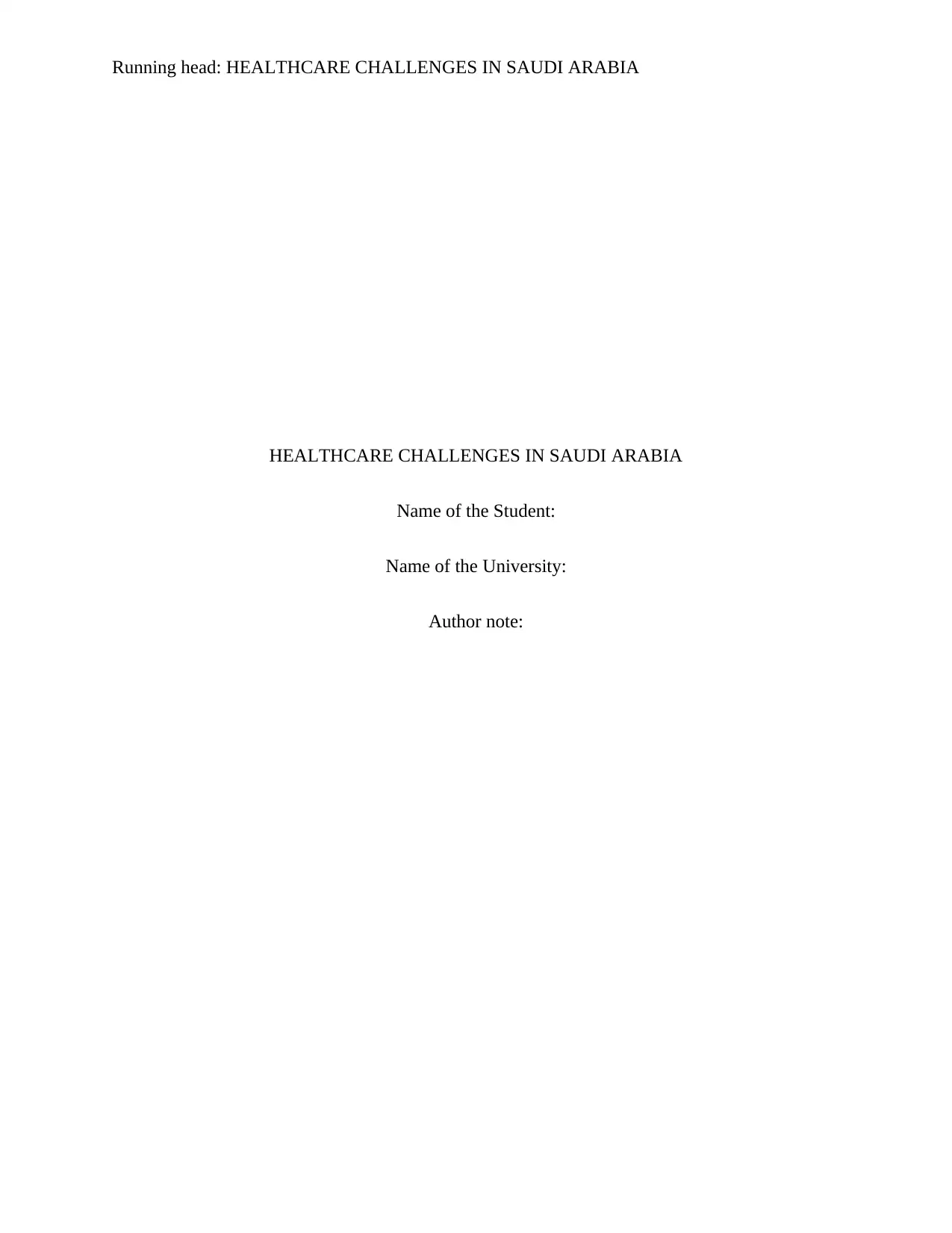
Running head: HEALTHCARE CHALLENGES IN SAUDI ARABIA
HEALTHCARE CHALLENGES IN SAUDI ARABIA
Name of the Student:
Name of the University:
Author note:
HEALTHCARE CHALLENGES IN SAUDI ARABIA
Name of the Student:
Name of the University:
Author note:
Secure Best Marks with AI Grader
Need help grading? Try our AI Grader for instant feedback on your assignments.
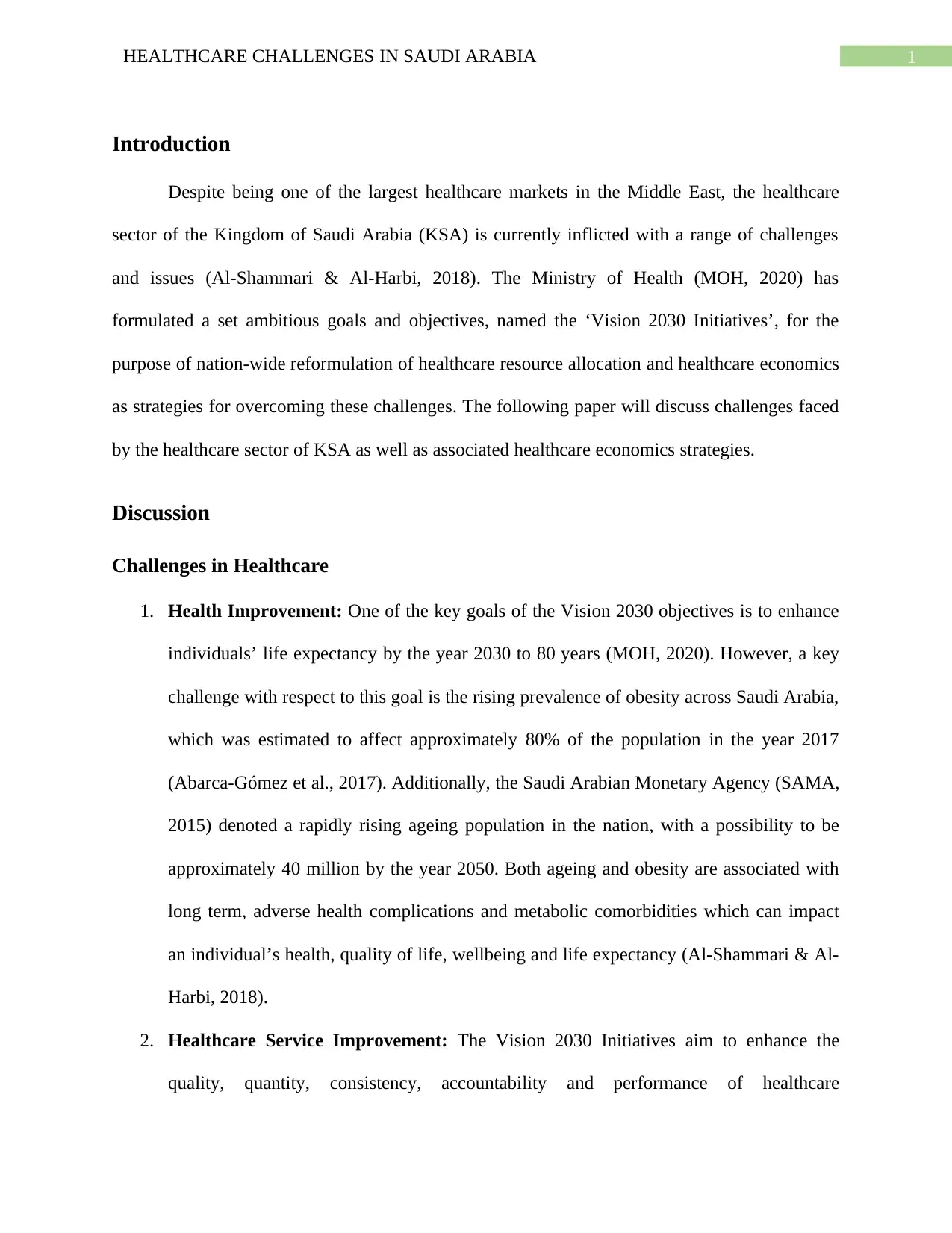
1HEALTHCARE CHALLENGES IN SAUDI ARABIA
Introduction
Despite being one of the largest healthcare markets in the Middle East, the healthcare
sector of the Kingdom of Saudi Arabia (KSA) is currently inflicted with a range of challenges
and issues (Al-Shammari & Al-Harbi, 2018). The Ministry of Health (MOH, 2020) has
formulated a set ambitious goals and objectives, named the ‘Vision 2030 Initiatives’, for the
purpose of nation-wide reformulation of healthcare resource allocation and healthcare economics
as strategies for overcoming these challenges. The following paper will discuss challenges faced
by the healthcare sector of KSA as well as associated healthcare economics strategies.
Discussion
Challenges in Healthcare
1. Health Improvement: One of the key goals of the Vision 2030 objectives is to enhance
individuals’ life expectancy by the year 2030 to 80 years (MOH, 2020). However, a key
challenge with respect to this goal is the rising prevalence of obesity across Saudi Arabia,
which was estimated to affect approximately 80% of the population in the year 2017
(Abarca-Gómez et al., 2017). Additionally, the Saudi Arabian Monetary Agency (SAMA,
2015) denoted a rapidly rising ageing population in the nation, with a possibility to be
approximately 40 million by the year 2050. Both ageing and obesity are associated with
long term, adverse health complications and metabolic comorbidities which can impact
an individual’s health, quality of life, wellbeing and life expectancy (Al-Shammari & Al-
Harbi, 2018).
2. Healthcare Service Improvement: The Vision 2030 Initiatives aim to enhance the
quality, quantity, consistency, accountability and performance of healthcare
Introduction
Despite being one of the largest healthcare markets in the Middle East, the healthcare
sector of the Kingdom of Saudi Arabia (KSA) is currently inflicted with a range of challenges
and issues (Al-Shammari & Al-Harbi, 2018). The Ministry of Health (MOH, 2020) has
formulated a set ambitious goals and objectives, named the ‘Vision 2030 Initiatives’, for the
purpose of nation-wide reformulation of healthcare resource allocation and healthcare economics
as strategies for overcoming these challenges. The following paper will discuss challenges faced
by the healthcare sector of KSA as well as associated healthcare economics strategies.
Discussion
Challenges in Healthcare
1. Health Improvement: One of the key goals of the Vision 2030 objectives is to enhance
individuals’ life expectancy by the year 2030 to 80 years (MOH, 2020). However, a key
challenge with respect to this goal is the rising prevalence of obesity across Saudi Arabia,
which was estimated to affect approximately 80% of the population in the year 2017
(Abarca-Gómez et al., 2017). Additionally, the Saudi Arabian Monetary Agency (SAMA,
2015) denoted a rapidly rising ageing population in the nation, with a possibility to be
approximately 40 million by the year 2050. Both ageing and obesity are associated with
long term, adverse health complications and metabolic comorbidities which can impact
an individual’s health, quality of life, wellbeing and life expectancy (Al-Shammari & Al-
Harbi, 2018).
2. Healthcare Service Improvement: The Vision 2030 Initiatives aim to enhance the
quality, quantity, consistency, accountability and performance of healthcare
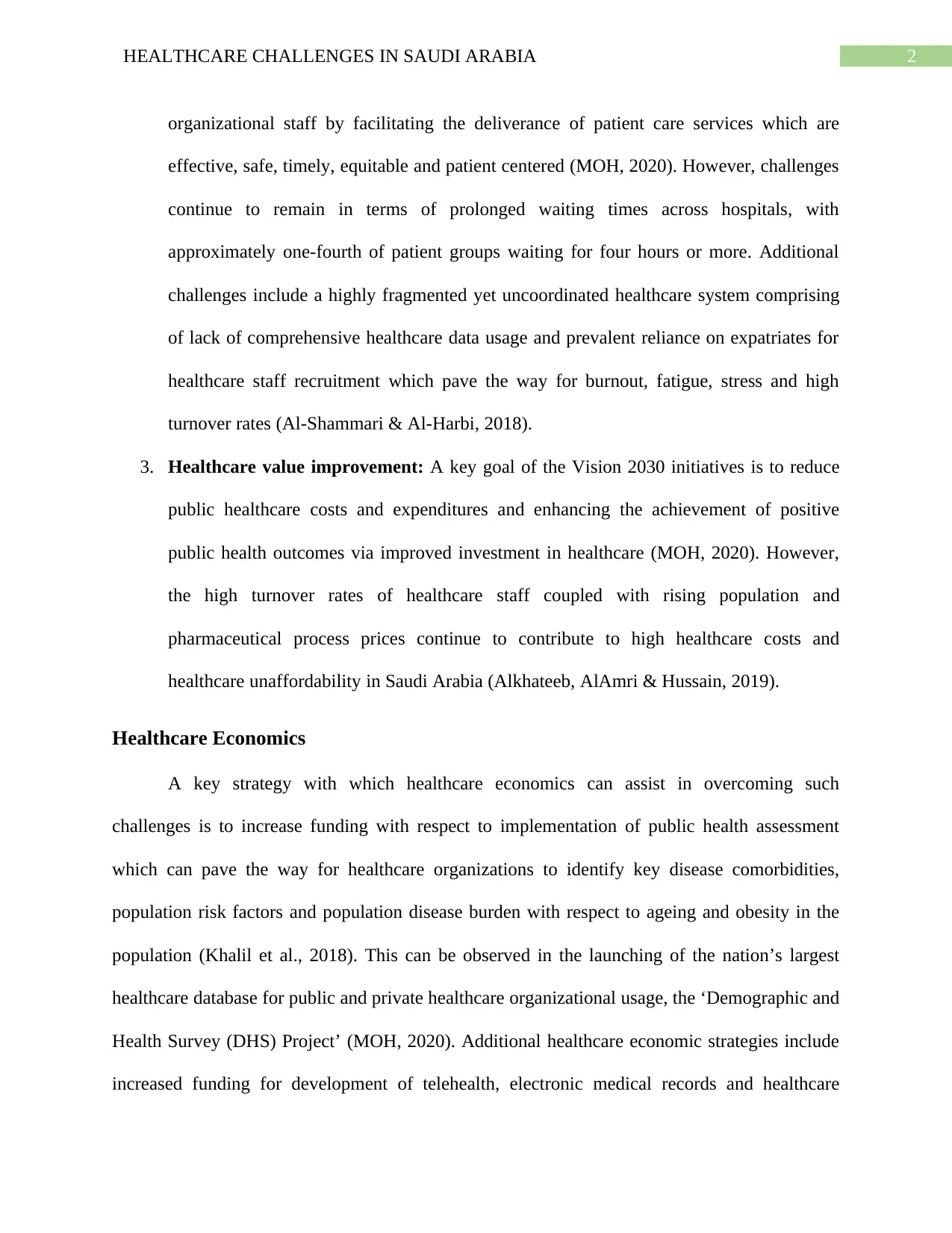
2HEALTHCARE CHALLENGES IN SAUDI ARABIA
organizational staff by facilitating the deliverance of patient care services which are
effective, safe, timely, equitable and patient centered (MOH, 2020). However, challenges
continue to remain in terms of prolonged waiting times across hospitals, with
approximately one-fourth of patient groups waiting for four hours or more. Additional
challenges include a highly fragmented yet uncoordinated healthcare system comprising
of lack of comprehensive healthcare data usage and prevalent reliance on expatriates for
healthcare staff recruitment which pave the way for burnout, fatigue, stress and high
turnover rates (Al-Shammari & Al-Harbi, 2018).
3. Healthcare value improvement: A key goal of the Vision 2030 initiatives is to reduce
public healthcare costs and expenditures and enhancing the achievement of positive
public health outcomes via improved investment in healthcare (MOH, 2020). However,
the high turnover rates of healthcare staff coupled with rising population and
pharmaceutical process prices continue to contribute to high healthcare costs and
healthcare unaffordability in Saudi Arabia (Alkhateeb, AlAmri & Hussain, 2019).
Healthcare Economics
A key strategy with which healthcare economics can assist in overcoming such
challenges is to increase funding with respect to implementation of public health assessment
which can pave the way for healthcare organizations to identify key disease comorbidities,
population risk factors and population disease burden with respect to ageing and obesity in the
population (Khalil et al., 2018). This can be observed in the launching of the nation’s largest
healthcare database for public and private healthcare organizational usage, the ‘Demographic and
Health Survey (DHS) Project’ (MOH, 2020). Additional healthcare economic strategies include
increased funding for development of telehealth, electronic medical records and healthcare
organizational staff by facilitating the deliverance of patient care services which are
effective, safe, timely, equitable and patient centered (MOH, 2020). However, challenges
continue to remain in terms of prolonged waiting times across hospitals, with
approximately one-fourth of patient groups waiting for four hours or more. Additional
challenges include a highly fragmented yet uncoordinated healthcare system comprising
of lack of comprehensive healthcare data usage and prevalent reliance on expatriates for
healthcare staff recruitment which pave the way for burnout, fatigue, stress and high
turnover rates (Al-Shammari & Al-Harbi, 2018).
3. Healthcare value improvement: A key goal of the Vision 2030 initiatives is to reduce
public healthcare costs and expenditures and enhancing the achievement of positive
public health outcomes via improved investment in healthcare (MOH, 2020). However,
the high turnover rates of healthcare staff coupled with rising population and
pharmaceutical process prices continue to contribute to high healthcare costs and
healthcare unaffordability in Saudi Arabia (Alkhateeb, AlAmri & Hussain, 2019).
Healthcare Economics
A key strategy with which healthcare economics can assist in overcoming such
challenges is to increase funding with respect to implementation of public health assessment
which can pave the way for healthcare organizations to identify key disease comorbidities,
population risk factors and population disease burden with respect to ageing and obesity in the
population (Khalil et al., 2018). This can be observed in the launching of the nation’s largest
healthcare database for public and private healthcare organizational usage, the ‘Demographic and
Health Survey (DHS) Project’ (MOH, 2020). Additional healthcare economic strategies include
increased funding for development of telehealth, electronic medical records and healthcare
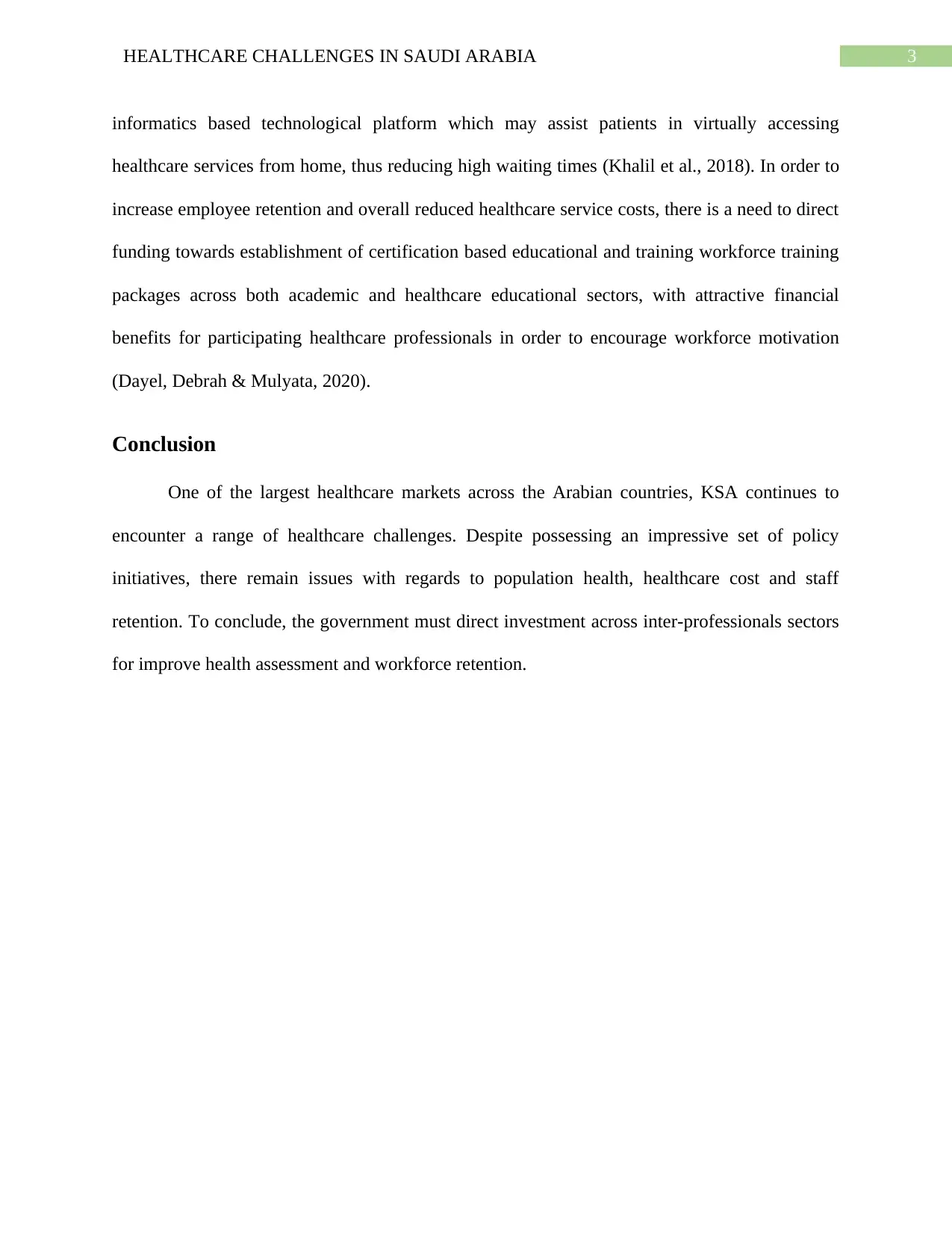
3HEALTHCARE CHALLENGES IN SAUDI ARABIA
informatics based technological platform which may assist patients in virtually accessing
healthcare services from home, thus reducing high waiting times (Khalil et al., 2018). In order to
increase employee retention and overall reduced healthcare service costs, there is a need to direct
funding towards establishment of certification based educational and training workforce training
packages across both academic and healthcare educational sectors, with attractive financial
benefits for participating healthcare professionals in order to encourage workforce motivation
(Dayel, Debrah & Mulyata, 2020).
Conclusion
One of the largest healthcare markets across the Arabian countries, KSA continues to
encounter a range of healthcare challenges. Despite possessing an impressive set of policy
initiatives, there remain issues with regards to population health, healthcare cost and staff
retention. To conclude, the government must direct investment across inter-professionals sectors
for improve health assessment and workforce retention.
informatics based technological platform which may assist patients in virtually accessing
healthcare services from home, thus reducing high waiting times (Khalil et al., 2018). In order to
increase employee retention and overall reduced healthcare service costs, there is a need to direct
funding towards establishment of certification based educational and training workforce training
packages across both academic and healthcare educational sectors, with attractive financial
benefits for participating healthcare professionals in order to encourage workforce motivation
(Dayel, Debrah & Mulyata, 2020).
Conclusion
One of the largest healthcare markets across the Arabian countries, KSA continues to
encounter a range of healthcare challenges. Despite possessing an impressive set of policy
initiatives, there remain issues with regards to population health, healthcare cost and staff
retention. To conclude, the government must direct investment across inter-professionals sectors
for improve health assessment and workforce retention.
Secure Best Marks with AI Grader
Need help grading? Try our AI Grader for instant feedback on your assignments.
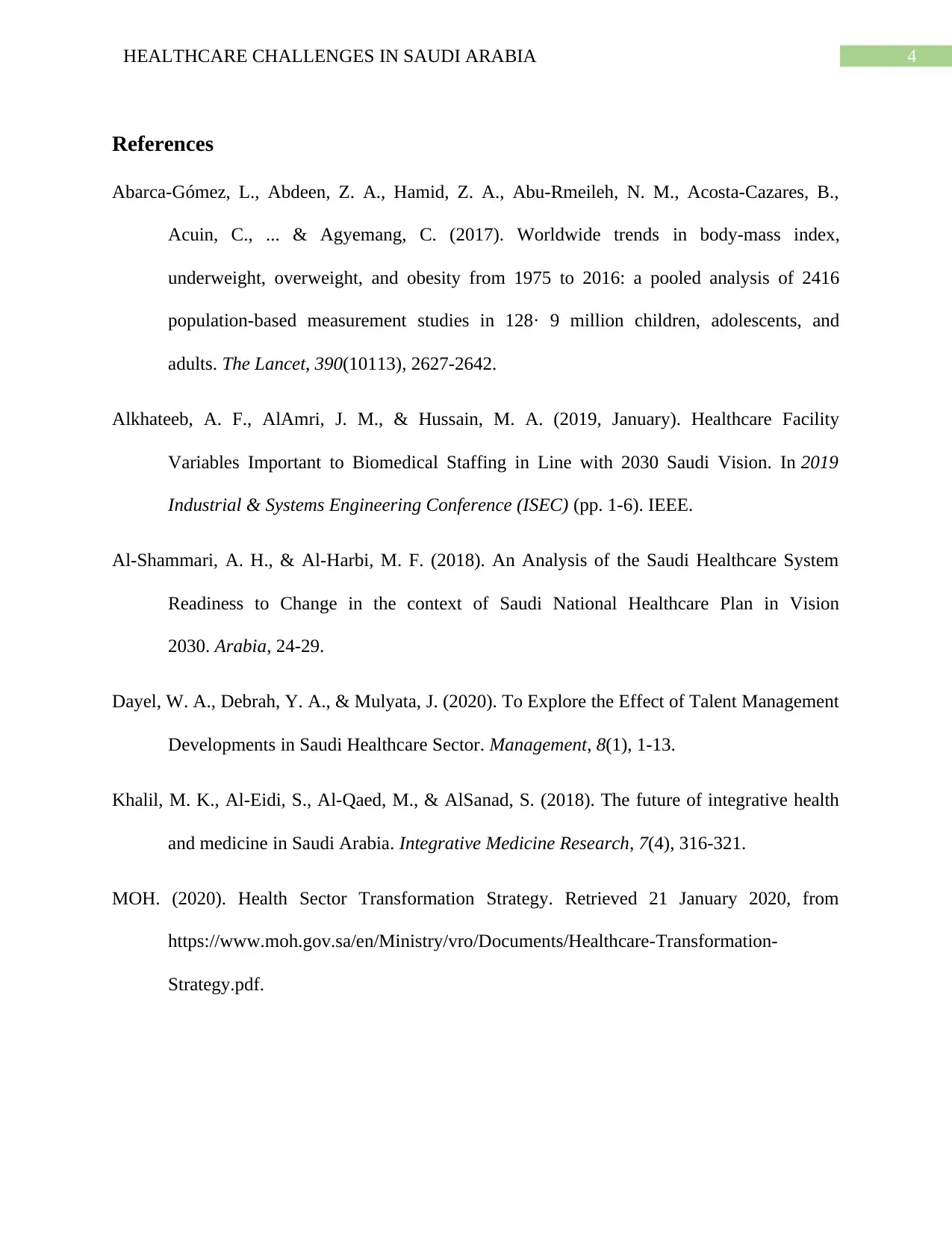
4HEALTHCARE CHALLENGES IN SAUDI ARABIA
References
Abarca-Gómez, L., Abdeen, Z. A., Hamid, Z. A., Abu-Rmeileh, N. M., Acosta-Cazares, B.,
Acuin, C., ... & Agyemang, C. (2017). Worldwide trends in body-mass index,
underweight, overweight, and obesity from 1975 to 2016: a pooled analysis of 2416
population-based measurement studies in 128· 9 million children, adolescents, and
adults. The Lancet, 390(10113), 2627-2642.
Alkhateeb, A. F., AlAmri, J. M., & Hussain, M. A. (2019, January). Healthcare Facility
Variables Important to Biomedical Staffing in Line with 2030 Saudi Vision. In 2019
Industrial & Systems Engineering Conference (ISEC) (pp. 1-6). IEEE.
Al-Shammari, A. H., & Al-Harbi, M. F. (2018). An Analysis of the Saudi Healthcare System
Readiness to Change in the context of Saudi National Healthcare Plan in Vision
2030. Arabia, 24-29.
Dayel, W. A., Debrah, Y. A., & Mulyata, J. (2020). To Explore the Effect of Talent Management
Developments in Saudi Healthcare Sector. Management, 8(1), 1-13.
Khalil, M. K., Al-Eidi, S., Al-Qaed, M., & AlSanad, S. (2018). The future of integrative health
and medicine in Saudi Arabia. Integrative Medicine Research, 7(4), 316-321.
MOH. (2020). Health Sector Transformation Strategy. Retrieved 21 January 2020, from
https://www.moh.gov.sa/en/Ministry/vro/Documents/Healthcare-Transformation-
Strategy.pdf.
References
Abarca-Gómez, L., Abdeen, Z. A., Hamid, Z. A., Abu-Rmeileh, N. M., Acosta-Cazares, B.,
Acuin, C., ... & Agyemang, C. (2017). Worldwide trends in body-mass index,
underweight, overweight, and obesity from 1975 to 2016: a pooled analysis of 2416
population-based measurement studies in 128· 9 million children, adolescents, and
adults. The Lancet, 390(10113), 2627-2642.
Alkhateeb, A. F., AlAmri, J. M., & Hussain, M. A. (2019, January). Healthcare Facility
Variables Important to Biomedical Staffing in Line with 2030 Saudi Vision. In 2019
Industrial & Systems Engineering Conference (ISEC) (pp. 1-6). IEEE.
Al-Shammari, A. H., & Al-Harbi, M. F. (2018). An Analysis of the Saudi Healthcare System
Readiness to Change in the context of Saudi National Healthcare Plan in Vision
2030. Arabia, 24-29.
Dayel, W. A., Debrah, Y. A., & Mulyata, J. (2020). To Explore the Effect of Talent Management
Developments in Saudi Healthcare Sector. Management, 8(1), 1-13.
Khalil, M. K., Al-Eidi, S., Al-Qaed, M., & AlSanad, S. (2018). The future of integrative health
and medicine in Saudi Arabia. Integrative Medicine Research, 7(4), 316-321.
MOH. (2020). Health Sector Transformation Strategy. Retrieved 21 January 2020, from
https://www.moh.gov.sa/en/Ministry/vro/Documents/Healthcare-Transformation-
Strategy.pdf.
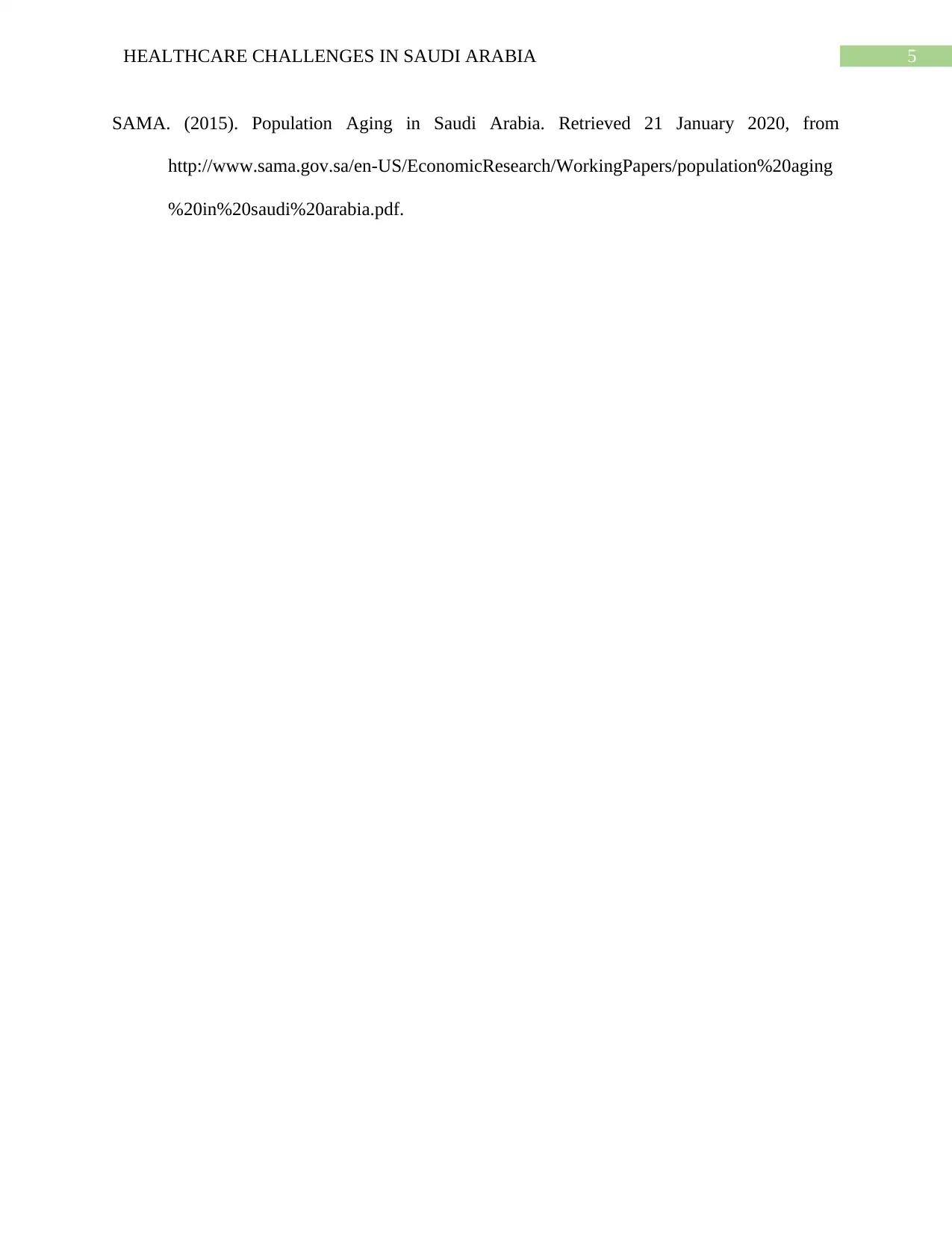
5HEALTHCARE CHALLENGES IN SAUDI ARABIA
SAMA. (2015). Population Aging in Saudi Arabia. Retrieved 21 January 2020, from
http://www.sama.gov.sa/en-US/EconomicResearch/WorkingPapers/population%20aging
%20in%20saudi%20arabia.pdf.
SAMA. (2015). Population Aging in Saudi Arabia. Retrieved 21 January 2020, from
http://www.sama.gov.sa/en-US/EconomicResearch/WorkingPapers/population%20aging
%20in%20saudi%20arabia.pdf.
1 out of 6
Related Documents
Your All-in-One AI-Powered Toolkit for Academic Success.
+13062052269
info@desklib.com
Available 24*7 on WhatsApp / Email
![[object Object]](/_next/static/media/star-bottom.7253800d.svg)
Unlock your academic potential
© 2024 | Zucol Services PVT LTD | All rights reserved.




